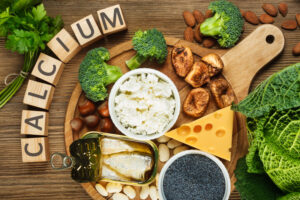 By David B. Milne – Human Nutrition Research Center
By David B. Milne – Human Nutrition Research Center
Osteoporosis, or the loss of bone, affects more than 25 million people in the United States, including one out of every three people over the age of 65. It is eight times more prevalent in women as in men. It is the major underlying cause of bone fractures in postmenopausal women and the elderly.
The chance one will have osteoporosis in later years is related to the amount and density of bone at the completion of growth. This depends largely on a person’s calcium intake and retention from birth through adolescence. And adequate intakes of magnesium and phosphorous are also important.
Recent surveys, however, indicate that about 60 percent of men and 90 percent of women don’t get the recommended amount of calcium. Surveys also show that self-selected diets also provide less than the recommended intake allowance for magnesium for a significant percentage of adults and teens.
Lower intakes of calcium and magnesium have been accompanied by a large increase in the consumption of non-diet sodas. Twenty years ago, the average teen drank as much milk as soda. Today, teens average twice as much soda as milk. Recent surveys have shown a rise in soda as the beverage of choice among many adults and teens.
Last fall, the Center for Science in the Public Interest publicized concerns that kids are guzzling too much “liquid candy” in the form of non-diet sodas at the expense of foods that are important for healthy bone growth. The average teen male drinks three cans of soda a day; the average teen girl drinks two.
These concerns are well founded. Studies at the Grand Forks Human Nutrition Research Center and other laboratories have shown that large amounts of fructose, the major sweetener in soft drinks, upsets the balance of minerals needed for healthy bones.
We found that when young men in their 20s and 30s downed 4 ½ cans of non-diet soda every day for six weeks, it upset their balance of major bone minerals; they retained less calcium and lost more phosphorous than they ate. The effect on the bone minerals was greatest when the diets were also low in magnesium.
There is a way to have sodas and keep the fizz in your bones. One or two sodas a day may be okay. However, people also need to eat foods that are rich in calcium and magnesium.
Milk and milk products are excellent sources of calcium and phosphorous. Calcium is also found in sardines, clams, oysters, and canned salmon. Dark green leafy vegetables, such as kale, collards, turnip greens, mustard greens and broccoli are good sources of both calcium and magnesium. Seeds, nuts, legumes, and cereal grains are additional sources of magnesium.
Carbonated drinks have a place, but in moderation. However, to assure healthy bones and quality of life, we must pay attention to the other beverages we drink and the foods we eat.
This news on calcium bone health is shared with you by Nutrition Breakthroughs, a provider of natural health articles and effective natural remedies since 2001. Nutrition Breakthroughs makes the original calcium and magnesium based sleep aid Sleep Minerals II, as well as Joints and More, the natural solution for joint relief, aches and pains and stronger hair and nails.


